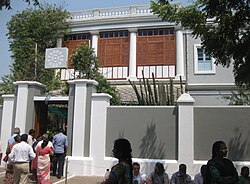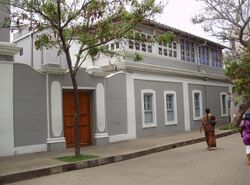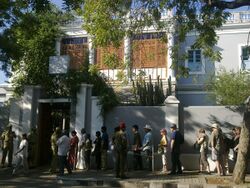Organization:Sri Aurobindo Ashram
 The Mother's symbol | |
 Entrance to Sri Aurobindo Ashram | |
| Formation | 24 November 1926 |
|---|---|
| Founder | Sri Aurobindo |
| Type | Spiritual community |
| Legal status | Foundation |
| Purpose | Educational, Philanthropic, Religious Studies, Spirituality, Meditation |
| Headquarters | Pondicherry, India |
| Coordinates | [ ⚑ ] : 11°56′12″N 79°50′03″E / 11.936708°N 79.834039°E |
Main organ | Sri Aurobindo Ashram Trust |
| Website | sriaurobindoashram.org |
The Sri Aurobindo Ashram (French: Ashram de Sri Aurobindo) is a spiritual community (ashram) located in Pondicherry, in the Indian territory of Puducherry. The ashram grew out of a small community of disciples who had gathered around Sri Aurobindo after he retired from politics and settled in Pondicherry in 1910. On 24 November 1926, after a major spiritual realization, Sri Aurobindo withdrew from public view in order to continue his spiritual work. At this time he handed over the full responsibility for the inner and outer lives of the sadhaks (spiritual aspirants) and the ashram to his spiritual collaborator, "The Mother or La Mère", earlier known as Mirra Alfassa. This date is therefore generally known as the founding-day of the ashram, though, as Sri Aurobindo himself wrote, it had "less been created than grown around him as its centre."[1]
History
Life in the community that preceded the ashram was informal. Sri Aurobindo spent most of his time in writing and meditation. The three or four young men who had followed him to Pondicherry in 1910 lived with him and looked after the household. Otherwise, they were free to do as they wished. The Mother and French writer Paul Richard met Sri Aurobindo in 1914 and proposed that they bring out a monthly review; but after the outbreak of World War I, they were obliged to leave India, and Sri Aurobindo had to do almost all of the work on the review himself, helped a little by the young men who were living with him. In April 1920 the Mother returned to Pondicherry, and soon the community began to take the form of an ashram, more because the sadhaks "desired to entrust their whole inner and outer life to the Mother than from any intention or plan of hers or of Sri Aurobindo."[2] After the ashram was given formal shape in 1926, it experienced a period of rapid growth, increasing from around 24 in the beginning of 1927 to more than 150 in 1934.[3] The membership leveled off in 1934 owing to a lack of suitable housing.
During these years there was a regular routine. At 6:00 every morning, the Mother appeared on the ashram balcony to initiate the day with her blessings. Sadhaks would have woken very early and completed a good portion of the day's work including meditation and then assembled under the balcony to receive her blessings.[4]
As the ashram grew, many departments came up and were looked after by the sadhaks as part of their sadhana: the offices, library, dining room, book/photograph printing, workshops, sports/playground, art gallery, dispensary/nursing home, farms, dairies, flower gardens, guest houses, laundry, bakery, etc. The heads of the departments met the Mother in the morning and took her blessings and orders. She would meet the sadhaks individually again at 10 am and, in the evening at 5:30 pm, she would conduct meditation and meet the sadhaks.
In addition, four times a year Sri Aurobindo and the Mother used to give public Darshans (spiritual gatherings where the guru bestows blessings) to thousands of devotees gathered to receive grace.
Present
This section does not cite any external source. HandWiki requires at least one external source. See citing external sources. (March 2023) (Learn how and when to remove this template message) |
Once confined to a few buildings in one corner of Pondicherry, the ashram's growth has caused it to expand physically in all directions. Today, Ashramites live and work in more than 400 buildings spread throughout the town. The central focus of the community is one group of houses, including those in which Sri Aurobindo and the Mother dwelt for most of their lives in Pondicherry. This interconnected block of houses—called "the Ashram main-building", or more usually just "the Ashram"—surrounds a tree-shaded courtyard, at the centre of which lies the flower-covered "Samadhi". This white marble shrine holds, in two separate chambers, the physical remains of Sri Aurobindo and the Mother.
Today, Pondicherry has become an important destination for spiritual seekers as well as tourists. Thousands of visitors from all over the world come to the ashram.
The visiting hours for the visitors are from 8 am to 12 noon and then again from 2 pm to 6 pm.
Aims and ideals
The Ashram, according to Sri Aurobindo, "has been created with another object than that ordinarily common to such institutions, not for the renunciation of the world but as a centre and a field of practice for the evolution of another kind and form of life which would in the final end be moved by a higher spiritual consciousness and embody a greater life of the spirit."[5]
The practice of Integral Yoga, Sri Aurobindo explained, "does not proceed through any set mental teaching or prescribed forms of meditation, mantras or others, but by aspiration, by a self-concentration inwards or upwards, by self-opening to an Influence, to the Divine Power above us and its workings, to the Divine Presence in the heart, and by the rejection of all that is foreign to these things."[6]
There are many things belonging to older systems that are necessary on the way—an opening of the mind to a greater wideness and to the sense of the Self and the Infinite, an emergence into what has been called the cosmic consciousness, mastery over the desires and passions; an outward asceticism is not essential, but the conquest of desire and attachment and a control over the body and its needs, greeds and instincts are indispensable. There is a combination of the principles of the old systems, the way of knowledge through the mind's discernment between Reality and the appearance, the heart's way of devotion, love and surrender and the way of works turning the will away from motives of self-interest to the Truth and the service of a greater Reality than the ego. For the whole being has to be trained so that it can respond and be transformed when it is possible for that greater Light and Force to work in the nature.
– Sri Aurobindo[7]
The complete method of Integral Yoga aims to transform human life into a divine life. In Sri Aurobindo's yoga, the highest aim is the state of being one with the Divine, without the renunciation of life in the world. For such a fulfillment of the consciousness, the urge for perfection must not be confined to a few individuals. There must be "a general spiritual awakening and aspiration in mankind" as well as "a dynamic re-creating of individual manhood in the spiritual type."[8] This would lead eventually to the emergence of a new type of being, the gnostic being, which "would be the hope of a more harmonious evolutionary order in terrestrial Nature".[9]
Publications
This section does not cite any external source. HandWiki requires at least one external source. See citing external sources. (March 2023) (Learn how and when to remove this template message) |
Sri Aurobindo Ashram is the primary publisher of the works of Sri Aurobindo and the Mother. As of January 2015 it keeps some 200 publications in English in print, of which 78 are books by Sri Aurobindo, 44 books by the Mother, 27 compilations from their works, and 47 books by other authors. These books are printed at the Sri Aurobindo Ashram Press, which has been in operation since the 1940s. They are distributed by SABDA, the Ashram's book distribution service, which has been in operation since the 1950s. SABDA also carries books relating to Sri Aurobindo, the Mother, and their yoga brought out by other publishers, making the number of English books on their list more than 600. The Ashram also publishes books in 17 other European and Indian languages, for a total of more than 550 publications. SABDA carries these and other non-English titles: in all there are 1678 titles in 23 languages.
The photographs of Sri Aurobindo and The Mother are printed in-house and is available from Ashram Reception Service. Sizes are available to suit table-top to large wall frames.
Collected works
The Complete Works of Sri Aurobindo (new edition) are being issued in 37 volumes, of which 36 have been published. The Collected Works of the Mother have been issued in 17 volumes.
Periodicals
The Ashram publishes a number of journals relating to the philosophy and yoga of Sri Aurobindo and the Mother. These are currently printed at the Sri Aurobindo Ashram Press, though several were earlier brought out in other cities. Some of Sri Aurobindo's works first appeared in these and other journals, among them The Advent, a quarterly, which has recently ceased publication. The most important journals in English are:
- Bulletin of Sri Aurobindo International Centre of Education (English-French, formerly Bulletin of Physical Education), quarterly, Pondicherry, since 1949
- Mother India (English), monthly, Pondicherry, since 1949
The Ashram press also prints several journals published by other organizations. These include:
- All India Magazine (English and other languages), monthly, Pondicherry
- Bartika (Bengali), quarterly, Calcutta, since 1942
- Srinvantu, quarterly, Calcutta, since 1956
- World Union (English), monthly, Pondicherry
Governance
During the early years of the community, Sri Aurobindo and the Mother imposed very few rules on the sadhaks, because they wished them to learn to direct their lives by looking for the divine guidance within. After 1926, written rules were circulated. The main rules were an absolute prohibition of alcohol, drugs, sex and politics. There were also a number of guidelines for the smooth functioning of the collective life of the community. These rules were collected in Rules and Regulations of Sri Aurobindo Ashram, copies of which are given to all members.
The Sri Aurobindo Ashram Trust was established in 1955 to administer the community and its assets. The trust board consists of five Trustees, the first of whom were chosen by the Mother herself. After her passing in 1973, the trustees have chosen replacements by consensus.
The main ashram departments are overseen by department heads who report to the trustees.
The Ashram, a public charitable trust, is open to all. No distinctions of nationality, religion, caste, gender, or age are observed. Members come from every part of India and many foreign countries. A large number of devotees from Pondicherry and Tamil Nadu visit the Ashram every day, and support the activities of the Ashram in various ways. Many say that they have benefited from the teachings of Sri Aurobindo and the Mother.[10] However, some feel that there is little mingling of ashramites and local people. According to a senior Ashram official, the practice of silence observed by the ashramites may have been misunderstood as rude behaviour.[11]
Controversy
In compliance with the Central Government's Sexual Harassment of Women at Workplace (Prevention, Prohibition and Redressal) Act, 2013, the Sri Aurobindo Ashram Trust constituted an Internal Complaints Committee in April 2014.[12]
In 2001, a female member was expelled from the ashram for violating a "mandatory rule".[13] Thereafter she filed charges of sexual harassment against various members. These charges were dismissed by committees and government agencies, all of which found the charges false.[14][15][16][17] The then chairperson of the National Commission for Women added that there "appeared to be malicious planning behind the complaints".[18]
See also
- Auroville (not part of Sri Aurobindo Ashram)
- Sri Aurobindo International School (not part of Sri Aurobindo Ashram)
- The Mother's International School (not part of Sri Aurobindo Ashram)
- Integral Life (Link to Ken Wilber; not part of Sri Aurobindo Ashram)
References
- ↑ Sri Aurobindo, Autobiographical Notes and Other Writings of Historical Interest (Pondicherry: Sri Aurobindo Ashram, 2006), p. 9.
- ↑ Autobiographical Notes, p. 103.
- ↑ Sri Aurobindo, Letters on Himself and the Ashram (Pondicherry: Sri Aurobindo Ashram, 2011), p. 581.
- ↑ Karmayogi Life and Teachings of Sri Aurobindo and the Mother, Mere Cie, Inc. online
- ↑ Letters on Himself and the Ashram, p. 593.
- ↑ Sri Aurobindo, Letters on Yoga – II (Pondicherry: Sri Aurobindo Ashram, 2013), p. 20.
- ↑ Autobiographical Notes, p. 549.
- ↑ Sri Aurobindo, The Human Cycle, The Ideal of Human Unity, War and Self-Determination (Pondicherry: Sri Aurobindo Ashram, 1997), p. 262.
- ↑ Sri Aurobindo, The Life Divine (Pondicherry: Sri Aurobindo Ashram, 2005), p. 1006.
- ↑ "Momentous arrivals in Puducherry and the calm celebrations". The Hindu. http://www.thehindu.com/news/cities/puducherry/momentous-arrivals-in-puducherry-and-the-calm-celebrations/article7070189.ece.
- ↑ "Sisters victims of Sri Aurobindo Ashram squabble". Deccan Chronicle. http://www.deccanchronicle.com/141221/nation-crime/article/sisters-victims-sri-aurobindo-ashram-squabble.
- ↑ Resolution No. 1270, 7 April 2014, http://www.sriaurobindoashram.org/regulatory/, retrieved 6 January 2016
- ↑ Report of the Enquiry Officer at the High Court of Chennai, 24 October 2002, https://wellwishersofsaa.files.wordpress.com/2015/01/2002_10_menon_enquiry_report.pdf, retrieved 14 January 2014
- ↑ Judgment of The Judicial Magistrate at Pondicherry, 23 November 2004, https://wellwishersofsaa.files.wordpress.com/2015/01/2004-11_judgement_jm_pondicherry.pdf, retrieved 14 January 2014
- ↑ Report of the Fact Finding Enquiry Officer (Government of Pondicherry) in the matter of complaints among the residents in Ambabhikshu House and certain other Ashramites, 10 January 2005, https://wellwishersofsaa.files.wordpress.com/2015/01/2005_1_nagaraj_enquiry_report.pdf, retrieved 14 January 2014
- ↑ "Charges against Aurobindo Ashram false". The Hindu. 19 January 2005. http://www.thehindu.com/2005/01/19/stories/2005011902791300.htm. Retrieved 14 January 2015.
- ↑ Enquiry Report of the National Human Right Commission, New Delhi, 12 April 2005, https://wellwishersofsaa.files.wordpress.com/2015/01/2005_04_nhrc_report.pdf, retrieved 14 January 2014
- ↑ "Five Aurobindo ashram inmates defy HC orders". The New Indian Express. 24 July 2010. http://www.newindianexpress.com/states/tamil_nadu/article186323.ece.
External links
 |




